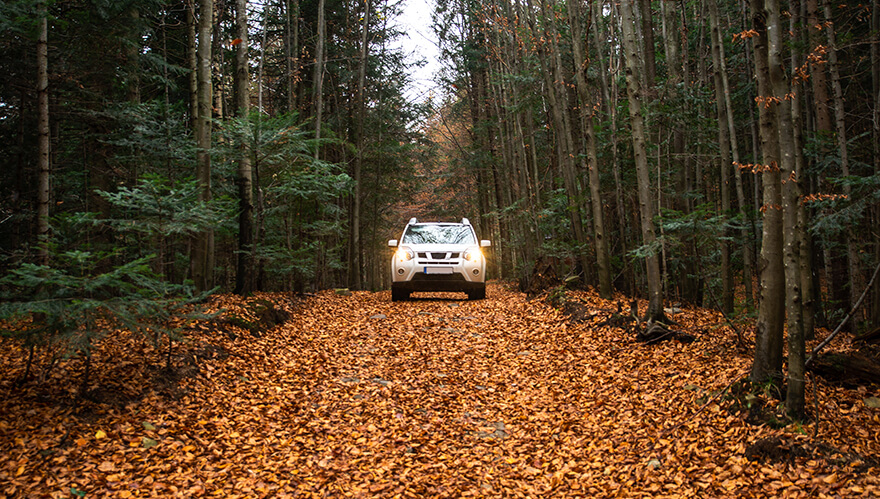
You have probably heard the terms Front wheel drive, Rear wheel drive, All wheel and 4-wheel Drive for years, without fully understanding what it means in relation to the car itself and to your driving experience. Here is all you need to know about the four types of drivetrains.
Front Wheel Drive is the most common vehicle drivetrain. Simply put, Front Wheel Drive means, the engine and the transmission are arranged or designed so power only goes to the front wheels of the vehicle. The engine turns the front wheels which pull the vehicle. It is also the most practical and efficient choice of drivetrain for all types of driving FWD allow for more room for passengers, as there is no drive shaft that needs to go to the rear wheels. The advantages of FWD are that it has a better fuel economy and achieves more mileage than a 4 wheel or rear wheel drive. There is improved traction overall as the weight of the engine and transmission are directly over the front tyres, which is particularly useful on snow covered or wet roads. In general, a front wheel drive car will have a more compact design as the power pack is smaller and located in the front of the vehicle. There is some evidence that passengers feel more comfortable in front wheel drive vehicles as the engine pulls the car from the front, rather than pushes from the back. The disadvantages of FWD can be an uneven tyre wear due to unequal weight distribution while road handling can be a bit more difficult especially during sudden acceleration. FWD cars a tendency to veer to the right or left due to something known as “torque steer.
Just as the name suggests, in Rear Wheel Drive vehicles the engine drives the rear wheels only. Most rear-wheel-drive vehicles have an engine mounted at the front of the car. It is situated lengthwise and drives the back wheels. Until the late 20th century, rear-wheel drive was the most common configuration for cars. For many motorists, RWD gives a smoother ride, feel better to drive. Rear wheel drive vehicles can handle twisty roads and great turning. On the downside, traction is less favourable, and this is aggravated when condition are slippery, wet, or snowy. A car or van that is pushed forward from the rear wheels is most useful when you routinely haul trailers or caravans. All trucks are usually rear wheel drive. This is true also of most super cars and rally cars, due to the better acceleration and responsiveness. Enthusiasts say that RWD are more the fun to drive and your lifestyle and driving needs should be taken into account when choosing RWD over FWD.
The main difference between and All Wheel Drive and a 4 Wheel Drive is simple. All wheels are driving the vehicle on AWD and the option to kick power to all four is optional on a 4WD. The All-Wheel Drive is driving power to all four wheels all the time. Both systems are made to maximise the traction needed for rough terrain. The average motorist might never encounter conditions that need a 4-wheel drive but there are some areas of the world, where winters in the wilderness mean the risk of getting stuck in a remote place, and often a 4WD or AWD is then required by law. For the average Irish motorist, having a car that drives power to all four wheels will be advantageous in muddy, rough, and icy conditions, but you can expect a lower fuel return for the privilege of driving this type of off-roading vehicle.
As always, we have a range of cars in all makes, models and drivetrains here at Sandyford Motor Centre. Browse online and/or check with our expert sales team for complete spec and full history on any of our cars.
Whilst all reasonable care has been taken to ensure the accuracy of this website. Sandyford Motor Centre does not make any warranties or representations to the accuracy, completeness or reliability of the information within or accessible through this website. Nor does Sandyford Motor Centre necessarily endorse, sponsor or approve any material accessible from this website. Sandyford Motor Centre assumes no responsibility for any unauthorised alteration or modification of any of the data herein by any other party. Neither Sandyford Motor Centre or any third parties who may provide Sandyford Motor Centre with information of dissemination accept any liability of any nature wheresoever arising from either the content of or the use or exploitation by any party of this website or any of the data or information contained in the website or accessible from the website. Unless stated otherwise all data and information on this website is the copyright of Sandyford Motor Centre whose authority must be obtained for any reproduction or for the linking of this website to any other site.